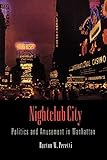Nightclub City : Politics and Amusement in Manhattan / Burton W. Peretti.
Material type: TextPublisher: Philadelphia : University of Pennsylvania Press, [2013]Copyright date: ©2007Description: 1 online resource (304 p.) : 14 illusContent type:
TextPublisher: Philadelphia : University of Pennsylvania Press, [2013]Copyright date: ©2007Description: 1 online resource (304 p.) : 14 illusContent type: - 9780812221572
- 9780812203363
- 974.71042
- online - DeGruyter
- Issued also in print.
| Item type | Current library | Call number | URL | Status | Notes | Barcode | |
|---|---|---|---|---|---|---|---|
 eBook
eBook
|
Biblioteca "Angelicum" Pont. Univ. S.Tommaso d'Aquino Nuvola online | online - DeGruyter (Browse shelf(Opens below)) | Online access | Not for loan (Accesso limitato) | Accesso per gli utenti autorizzati / Access for authorized users | (dgr)9780812203363 |
Browsing Biblioteca "Angelicum" Pont. Univ. S.Tommaso d'Aquino shelves, Shelving location: Nuvola online Close shelf browser (Hides shelf browser)

|

|

|

|

|

|

|
||
| online - DeGruyter A Voice for Human Rights / | online - DeGruyter Censorship and Cultural Sensibility : The Regulation of Language in Tudor-Stuart England / | online - DeGruyter Before Harlem : The Black Experience in New York City Before World War I / | online - DeGruyter Nightclub City : Politics and Amusement in Manhattan / | online - DeGruyter Many Identities, One Nation : The Revolution and Its Legacy in the Mid-Atlantic / | online - DeGruyter Monastic Bodies : Discipline and Salvation in Shenoute of Atripe / | online - DeGruyter The Phenomenon of Torture : Readings and Commentary / |
Frontmatter -- Contents -- Preface -- Chapter 1. The 1920s New York Nightclub, a Modern Institution -- Chapter 2. "The Hostess Evil" -- Chapter 3. Tammany Nights -- Chapter 4. "War on the Nightclubs" -- Chapter 5. Bargain-Counter Broadway -- Chapter 6. "Where Fleshpots And Politics Together Meet" -- Chapter 7. Nightlife in the La Guardia Era -- Chapter 8. A New Deal for Nightclubs -- Chapter 9. Billy Rose and Nightclubs for The Masses -- Chapter 10. The Nightclub Era in Retrospect -- Notes -- Index -- Acknowledgments
restricted access online access with authorization star
http://purl.org/coar/access_right/c_16ec
In the Roaring Twenties, New York City nightclubs and speakeasies became hot spots where traditions were flouted and modernity was forged. With powerful patrons in Tammany Hall and a growing customer base, nightclubs flourished in spite of the efforts of civic-minded reformers and federal Prohibition enforcement. This encounter between clubs and government-generated scandals, reform crusades, and regulations helped to redefine the image and reality of urban life in the United States. Ultimately, it took the Great Depression to cool Manhattan's Jazz Age nightclubs, forcing them to adapt and relocate, but not before they left their mark on the future of American leisure.Nightclub City explores the cultural significance of New York City's nightlife between the wars, from Texas Guinan's notorious 300 Club to Billy Rose's nostalgic Diamond Horseshoe. Whether in Harlem, Midtown, or Greenwich Village, raucous nightclub activity tested early twentieth-century social boundaries. Anglo-Saxon novelty seekers, Eastern European impresarios, and African American performers crossed ethnic lines while provocative comediennes and scantily clad chorus dancers challenged and reshaped notions of femininity. These havens of liberated sexuality, as well as prostitution and illicit liquor consumption, allowed their denizens to explore their fantasies and fears of change.The reactions of cultural critics, federal investigators, and reformers such as Fiorello La Guardia exemplify the tension between leisure and order. Peretti's research delves into the symbiotic relationships among urban politicians, social reformers, and the business of vice. Illustrated with archival photographs of the clubs and the characters who frequented them, Nightclub City is a dark and dazzling study of New York's bygone nightlife.
Issued also in print.
Mode of access: Internet via World Wide Web.
In English.
Description based on online resource; title from PDF title page (publisher's Web site, viewed 24. Apr 2022)


